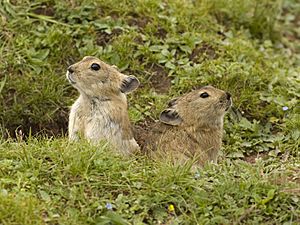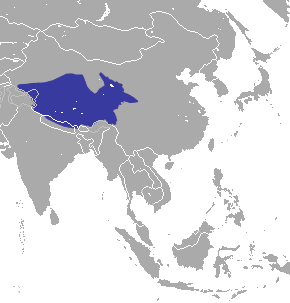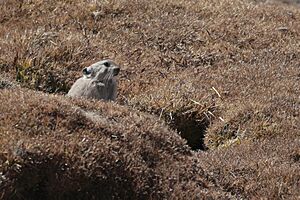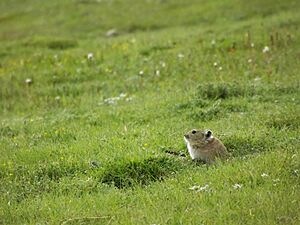Plateau pika facts for kids
Quick facts for kids Plateau pika |
|
|---|---|
 |
|
| Conservation status | |
| Scientific classification | |
| Genus: |
Ochotona
|
| Species: |
curzoniae
|
 |
|
| Plateau pika range | |
The plateau pika (Ochotona curzoniae), also called the black-lipped pika, is a small mammal related to rabbits. It belongs to the pika family, called Ochotonidae.
This animal is active during the day and does not hibernate in winter. An adult pika weighs about 140 grams. They have reddish-tan fur on their backs and yellowish-white fur on their bellies.
Plateau pikas prefer to live in high places, from 3,100 to 5,000 meters above sea level. They are mostly found on the Tibetan Plateau, which is why they are called "plateau" pikas. You can find them in China, India, and Nepal. They live in high deserts, grasslands, and mountain forests.
Contents
Role in the Ecosystem
Plateau pikas are very important to their environment. They are known as a keystone species. This means they play a big role in keeping their ecosystem healthy.
Helping the Soil
Pikas help recycle nutrients in the soil. Their burrowing also helps to aerate the soil. This makes the soil healthier for plants to grow.
Food for Other Animals
These pikas are a main food source for many predators. These include foxes, weasels, falcons, Asia pole cats, upland buzzards, and owls. Brown bears in the Hoh Xil area of the Tibetan Plateau especially love to eat plateau pikas.
Creating Homes
Pika burrows also create small homes for other creatures. Small birds and reptiles sometimes use these burrows as nests. The pikas' activity can also increase the variety of plants in an area.
Reproduction and Family Life
Plateau pikas are social animals. They live in family groups of two to five adults and their young. These groups can have different mating systems. Some are monogamous, meaning one male and one female. Others are polygynandrous, with about three males and three to four females per family.
Raising Young
Females can have many litters of babies. They can produce 2 to 5 litters, with 2 to 7 babies in each. There is only about a three-week break between litters. This quick breeding makes them one of the fastest-growing groups of their kind.
Their breeding season runs from April to August. Young pikas usually stay with their family during their first year. Both male and female pikas help protect their family. They show aggressive behavior to intruders. Males also make alarm calls to warn about predators.
Amazing Adaptations
Plateau pikas live in very cold places. Unlike some other animals, they do not hibernate to escape the cold. Because of this, they have special body adaptations to help them survive.
Staying Warm
One important adaptation is their high resting metabolism. This means their bodies naturally produce a lot of heat. They also have a special way of making heat without shivering. This is called non-shivering thermogenesis.
Pikas can also change the type of fat in their bodies. They can turn white fat into brown fat. Brown fat is very good at producing heat. This helps them stay warm even in extremely cold weather.
Conservation and Management
The plateau pika is a keystone species, meaning it's vital for its ecosystem. However, some people see them as a pest. This is because pikas eat plants that farmers' livestock, like yaks and sheep, also eat. This can affect the farmers' way of life.
Protecting Pikas
Many efforts are being made to protect plateau pikas. One way is to teach local communities about how important pikas are. They learn about the pikas' role in the environment. People are also encouraged to use farming methods that don't harm the pikas. This might include using fences to protect crops instead of trying to remove the animals.
Safe Areas for Wildlife
Another strategy is to create protected areas. These are places where pikas and other wildlife can live safely. For example, the Sanjiangyuan National Nature Reserve in China protects pikas and other endangered species. This reserve covers a large part of the Tibetan Plateau.
Learning More About Pikas
Scientists are also studying pikas. They want to understand more about their lives and how they fit into the ecosystem. This information helps create better plans for protecting them.
Overall, conservation efforts aim to help plateau pikas survive for a long time. They also want to support sustainable living in the region. By protecting this important animal, people hope to keep the high-altitude ecosystem healthy for future generations.




